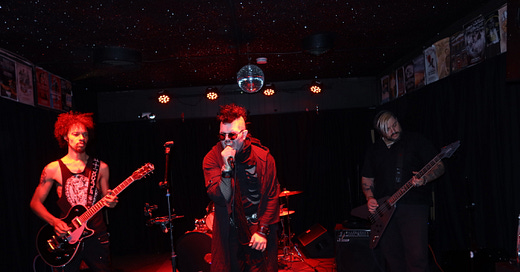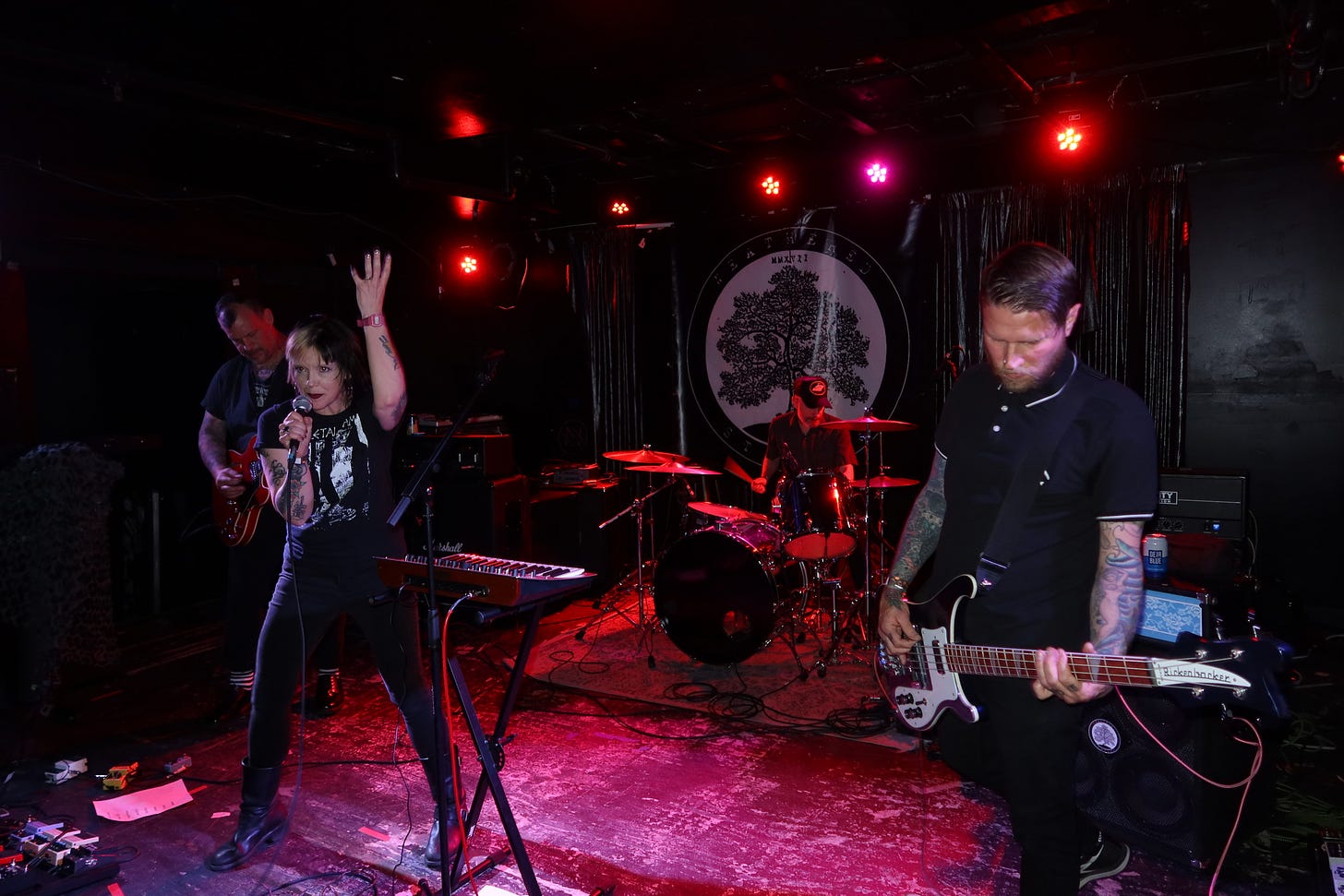November 2024 marked the seventh anniversary of Eventually It Will Kill You, the record label and promotion group run by Brian Castillo. If you go to an EIWKY event, chances are it will feature live performances by some of the most cutting-edge underground artists rooted in the current post-punk and darkwave-adjacent movement. Also in November, a two-day mini-festival was curated by Denver Blood Cult, a booking collective that has brought in other branches of similarly-minded music. Earlier in the year, Colorado Goth Fest was hosted at HQ, signaling yet another subset of what is an undeniable phenomenon—a widening popular interest in goth, darkwave, post-punk, industrial and related music over the last 15 years. What has made this trend more noteworthy is that much of it happened without direct connection with the goth subculture that has existed in many cities including Denver.
Denver’s goth scene goes back to at least the 1980s. Bands like Your Funeral, which once opened for The Birthday Party at The Mercury Cafe, Boulder gloom punkers Electric Third Rail, and deathrock band Soul Merchants, which included legendary recording engineer Bob Ferbrache, were luminaries of that early scene. But throughout the 90s, when goth nights were a regular thing at local clubs, other artists came to be known, like Seraphim Shock (who are still around but now based in Georgia), Blackcell (also still a thing), Faces Under the Mirror (ditto), Pure Drama, and The Siren Project (who occasionally still play). That phase of the local goth scene had major events including the Denver Dark Arts Festival at the now defunct downtown dance club/venue Rock Island in the early 2000s. At that time, electric body music (EBM) and future pop was in its heyday, but artists such as Emergence played alongside their more rock-oriented peers like Fiction 8, Caustic Soul, and Born in Winter in a fairly diverse scene, with bands you could spend paragraphs naming. But that scene really lost steam around the second half of the 2000s, though plenty of the more enduring electronic artists persisted. It seemed like the goth scene stayed in a spiral of EBM and future pop for years, with legacy artists still garnering attention.
But the late 2000s and early 2010s saw bands emerge who found inspiration in death rock and old post-punk, as well as classic industrial music. However, these bands’ interests also crossed over into noise (recalling the older goth scene), dance music, indie rock and shoegaze. There wasn’t a name for what was emerging, and it was not music generally embraced the local goth scene. Portland’s Soft Kill were early adopters of that sound when the group got going in 2010, but in other corners of the American underground, similar impulses were bubbling up.
Denver’s Echo Beds played its first show in 2010 after forming with Keith Curts and Tom Nelsen, who both had origins in local post-hardcore, garage rock, and experimental music. Their new concern was much more focused on a kind of tribal industrial sound, with electrifyingly visceral percussion that would begin to include a live setup with two metal barrels, robust amplification, bass guitar, power electronics, and feral vocals. A band called Sew Buttons on Ice Cream came out of avant-garde heavy music and political punk, as David Samuelson and Shannon Webber formed the group that would soon call itself Church Fire around 2011, producing some of the most commanding, melodic, industrial dance music around. At that time, no one would have identified either as having been part of a movement, and locally there were few bands like them. But over the next few years, their unintended kinship with like-minded artists worldwide would become obvious.
Toward the middle of the 2010s, there was a surge of music called “darkwave,” a blanket term for music influenced by post-punk, industrial, dark synthpop, minimal synth and/or coldwave—a sound that wasn’t simply the next post-punk revival. In those early days the genre was very much linked with the national DIY underground circuit, so you could see shows with, say, Baltimore’s industrial dark pop duo Curse, along with Church Fire and Echo Beds, on the same bill at DIY space Rhinoceropolis in Denver without it being defined as a darkwave show. Those DIY/underground connections also meant most if not all of those early darkwave adjacent shows happened at DIY spaces in Denver.
What cemented the fact that something exciting and inspiring was happening occurred when I was invited to go on tour with Echo Beds in 2014 to the Midwest, which was the last place I would have expected to find music that would resonate directly with what founders Tom and Keith were doing. But the tour launch show with experimental doom juggernauts The Body at Mutiny Information Cafe set the tone for the best tour I have been on to date. The tour took us first to a largely abandoned edge of Kansas City at a three-story collective run by art students and industrial music weirdos called Negative Space, then to a show in Iowa City in a house basement that had to be moved to the basement of another house a few blocks away due to a noise complaint. Another show date happened in Chicago with a concert booked at what seemed like a still-functioning porn theater. Afterwards we spent a few days in Minneapolis and witnessed minimal synth and industrial music at a festival and a super secret house show in a residential neighborhood that hosted regular D&D sessions. On the way back to Denver there was a show at one of the coolest record stores in the country, Total Drag, in Sioux Falls, South Dakota. And the tour finished with a night at a space that was part of a building that once housed Saddle Creek Records in Omaha. At every turn, we met or reconnected with amazing and interesting people who were plugged into an underground music community and, if not directly involved in the nascent darkwave scene, were at least open to hosting and supporting it.
The momentum I felt from that tour in 2014 wasn’t an anomaly. Darkwave bands were popping up over the next decade and experiencing varying levels of popularity and success. Certainly, Boy Harsher has gained great popularity, and I once traveled with Denver industrial-shoegaze-post-punk greats Voight to Santa Fe to see them at a warehouse, before staying the night with two of the founders of Meow Wolf, before the art wonderland expanded to Denver.
Since the 2010s, it seems as though the current era of darkwave in Denver and elsewhere has been marked by more accessibility for people outside of the DIY underground, and that may partially be due to the COVID-19 pandemic and the closure of so many of the usual spots the bands used to play, along with a greater awareness of the music overall. Rather than being held at special sites that often required some level of insider knowledge about the DIY music scenes, the events took place at more commercial establishments. With at least three active promoters in Denver-focused on goth and darkwave music and their creative kin and DJ nights catering to the subculture—e.g., Milk Bar, Dark Tuesdays at HQ, Possessor at 715 Club, events at The Crypt—the infrastructure to support the darkwave scene and help it flourish are now very much in place. Over the past five years, new bands in this space are also attracting more local fans to the live music scene. With one-man industrial dance cult Hex Cassette; electronic industrial artist Sell Farm; hyperpop project Gwisina; industrial punk performance artist Aeon Exit; death rockers such as WitchHands, Weathered Statues, and Radio Scarlet; and post-punk acts like Voight, Plague Garden, Cherished, and Church Fire going stronger than ever, there has never been a better time to get into the new darkwave.





